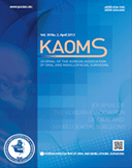Journal of the Korean Association of Oral and Maxillofacial Surgeons
- P-ISSN2234-7550
- E-ISSN2234-5930
- SCOPUS, KCI, ESCI
 ISSN : 2234-7550
ISSN : 2234-7550
Comparative study on the osseointegration of implants in dog mandibles according to the implant surface treatment
김수관 (조선대학교)
오지수 (조선대학교)
유재식 (조선대학교)
정경인 (건양대학교)
임성철 (조선대학교)
정미애 (강원대학교)
Abstract
Objectives: This study compared the impact of implant surface treatment on the stability and osseointegration of implants in dog mandibles.Materials and Methods: Six adult dogs received a total of 48 implants that were prepared using four different surface treatments; resorbable blast media (RBM), hydroxyapatite (HA), hydrothermal-treated HA, and sand blasting and acid etching (SLA). Implants were installed, and dogs were sepa-rated into 2- and 4-week groups. Implant stability was evaluated via Periotest M, Osstell Mentor, and removal torque analyzers. A histomorphometric analysis was also performed.Results: The stability evaluation showed that all groups generally had satisfactory values. The histomorphometric evaluation via a light microscope revealed that the HA surface implant group had the highest ratio of new bone formation on the entire fixture. The hydrothermal-treated HA surface im-plant group showed a high ratio of bone-to-implant contact in the upper half of the implant area.Conclusion: The hydrothermal-treated HA implant improved the bone-to-implant contact ratio on the upper fixture, which increased the implant sta-bility.
- keywords
- Dental implants, Osseointegration
- 다운로드 수
- 조회수
- 0KCI 피인용수
- 0WOS 피인용수